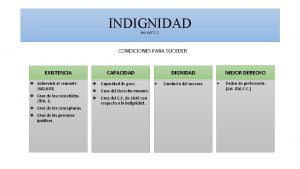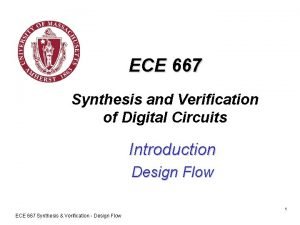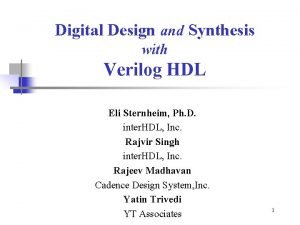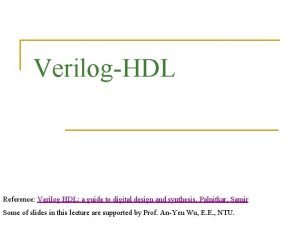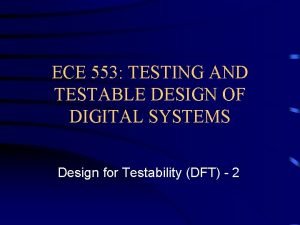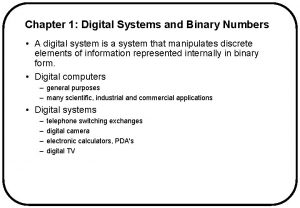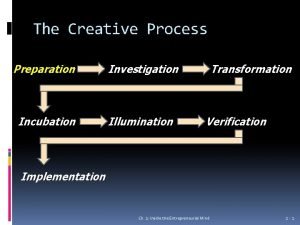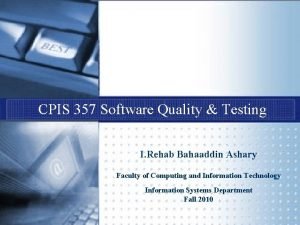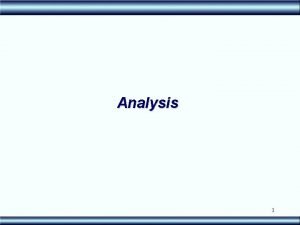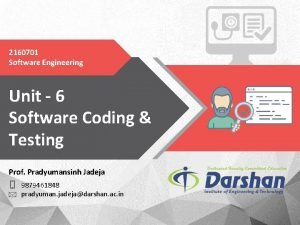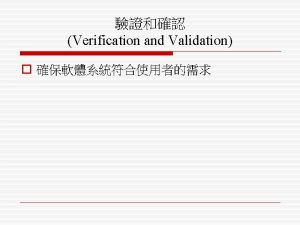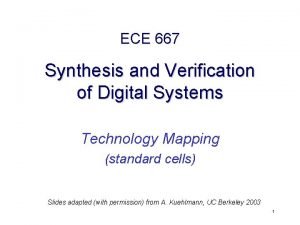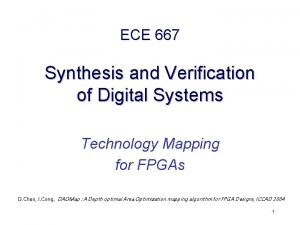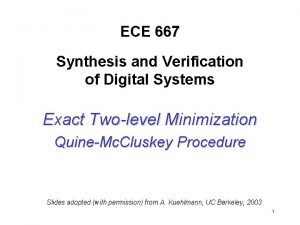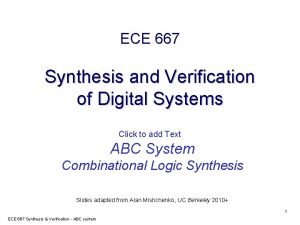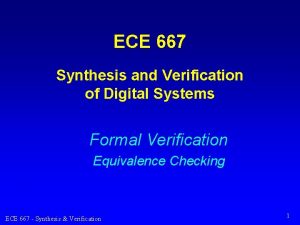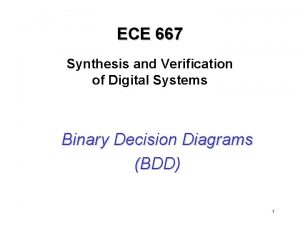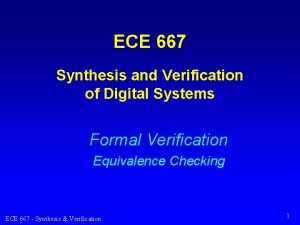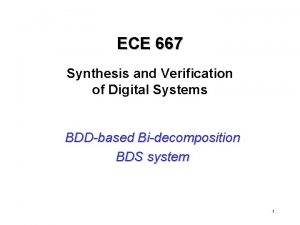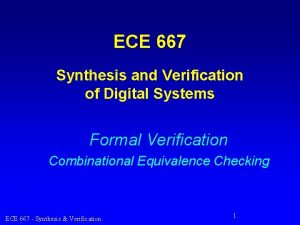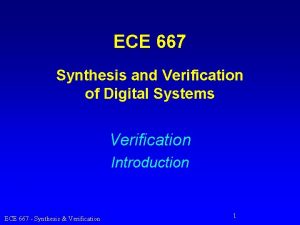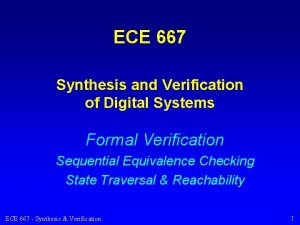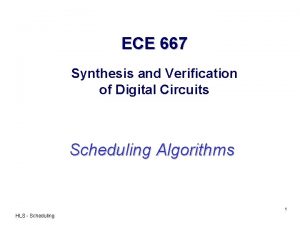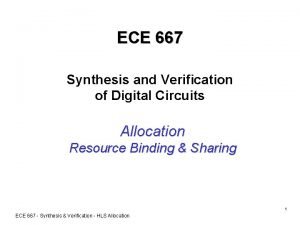ECE 667 Synthesis and Verification of Digital Systems

















- Slides: 17

ECE 667 Synthesis and Verification of Digital Systems Verification Introduction ECE 667 - Synthesis & Verification 1

Outline • Motivation: what is verification, why we need it • Verification methods – Formal methods – Simulation-based functional verification – Deterministic test generation ECE 667 - Synthesis & Verification 2

Verification • Design verification = ensuring correctness of the design – against its implementation (at different levels) – against alternative design (at the same level) ? model behavior function ? ? structure Design 1 HDL / RTL ? Logic level Design 2 RTL Logic level ? Gate level Mask level ? layout ECE 667 - Synthesis & Verification 3 ?

Why Verification • Verification crisis – System complexity, difficult to manage – More time, effort devoted to verification (70%) than to design – Need automated verification methods, integration • Consequences – Disasters, life threatening situations – Inconvenience (Pentium bug … ? ) – Many more … ECE 667 - Synthesis & Verification 4

Verification Methods • Deductive verification • Model checking Formal Verification • Equivalence checking • Simulation - performed on the model • Emulation, prototyping – product + environment • Testing - performed on the actual product (manufacturing test) ECE 667 - Synthesis & Verification 5

Functional Verification Simulation-based: Validation • Goal: verify the design in the full operational context • RTL functional verification – Verify specification (HDL) of RTL model – No model to check against: must simulate – Functional simulation • Functional test generation – Automatically generate tests: high-level transactions on data, clocking, control – SAT based methods ECE 667 - Synthesis & Verification 6

Evaluating Test Coverage • Coverage metrics - facilities to measure the effectiveness of functional verification – Monitors: collect data about testing (coverage, profile) – Code coverage • low-level coverage statistics for states, transitions, HDL model line coverage – Functional verification coverage • statistics, monitors for events, state transition sequences (transactions), data sets – Self-checking tests ECE 667 - Synthesis & Verification 7

Functional Test Generation • Given an RTL design and a coverage metric, must reach the predefined coverage goal • Solution: Solution run functional simulation – Directed tests • manual, often easy to generate (e. g. instruction set) • reliable (predictable coverage), but • not efficient (cover small portion of design) – Random tests • efficient (fast), but not reliable (unpredictable coverage) – Deterministic tests • Automatically generated • Constraints (user-defined, environment, coverage metrics) • Challenging to compute ECE 667 - Synthesis & Verification 8

Functional Verification - typical scenario 100 % Deterministic tests ? 100. 0 Coverage 95 % Pseudo-random directed tests (reliable and efficient) Normalized verification test cycles 1. 0 50 % Manual directed tests (reliable, not efficient) Test development time ECE 667 - Synthesis & Verification 9

Functional Test Generation • Random and pseudo-random methods • Directed pseudo-random simulation • Deterministic Methods – SAT-based methods • Boolean satisfiability • Mixed, arithmetic/Boolean satisfiability – Symbolic simulation – ATPG-based methods ECE 667 - Synthesis & Verification 10

Test Generation using Boolean SAT • Given an RTL specification of a combinational circuit • Simulate the design (pseudo-random, targeted vectors) • Code coverage OK ? module If not - expand the underlying logic: Boolean function ECE 667 - Synthesis & Verification input ports, output ports, internal signals begin. . . If (condition) then assignal = function( ); end if; . . . end module 11

B-SAT - Solving SAT using BDDs Boolean logic + constraints • Add constraints (modify the logic) • Build BDDs for each output, s. to constraints • Build the product BDD (AND of all BDDs) – If the set is empty, infeasible SAT instance – Otherwise: set of all satisfying assignments, test. ECE 667 - Synthesis & Verification 12

A simple B-SAT example • Given: output value requirements for a circuit • Compute: satisfying assignments at the inputs a b c d u v w • Output requirements: u=1, v=1, w=1 • SAT assignments: a, b, c, d = ? ECE 667 - Synthesis & Verification 13

How does B-SAT work ? H • Boolean satisfiability analysis – H = product BDD a • set of all satisfying solutions – to test for H = 1 (0), find a path in the BDD to terminal 1 (0) – the path, expressed in function variables, gives a satisfying solution (test vector) {1, 1, -}, {1, 0, 1} ECE 667 - Synthesis & Verification b ab c 0 ab’c 14 1

Functional test generation using Symbolic Simulation • Deterministic test pattern generation – Formulate a SAT problem for a complex combinational design – Solve SAT: find a set of satisfying assignment Module DUT … always @ (clk) begin A=? B=? + c=? * extract < if (A+B < B*C) out = x; else out = a & b x=? a=? b=? end ECE 667 - Synthesis & Verification 15 0 1 out

Formal Verification • Deductive reasoning (theorem proving) – Uses axioms, rules to prove system correctness – No guarantee that it will terminate – Difficult, time consuming: for critical applications only • Model checking – Automatic technique to prove correctness of concurrent systems: digital circuits, communication protocols, etc. – Practical tools become available, popular in industry • Equivalence checking – Check if two designs are equivalent – OK for combinational circuits, unsolved for sequential systems ECE 667 - Synthesis & Verification 16

Formal Verification • Equivalence checking – Takes two designs and makes a miter (AIG) Equivalence checking • Property checking – Takes design and property and makes a miter (AIG) • Prove that result is 0 (un. SAT) The goals are the same: to transform AIG until the output is proved constant 0 ABC is very effective at doing it ECE 667 - Synthesis & Verification 0 D 1 D 2 Property checking p 0 D 1 17
 Art. 667 cc
Art. 667 cc Ntp 667
Ntp 667 Zline 667-36
Zline 667-36 667
667 Systems engineering verification methods
Systems engineering verification methods Verilog hdl a guide to digital design and synthesis
Verilog hdl a guide to digital design and synthesis Verilog hdl
Verilog hdl E-commerce digital markets digital goods
E-commerce digital markets digital goods Digital systems testing and testable design
Digital systems testing and testable design Introduction to analog and digital control systems
Introduction to analog and digital control systems Bcd addition of 184 and 576
Bcd addition of 184 and 576 Introduction to digital control
Introduction to digital control Verification in creative process
Verification in creative process Verification and validation
Verification and validation Verification and validation
Verification and validation Unit-6
Unit-6 Validation plan
Validation plan Verification principle strengths and weaknesses
Verification principle strengths and weaknesses
